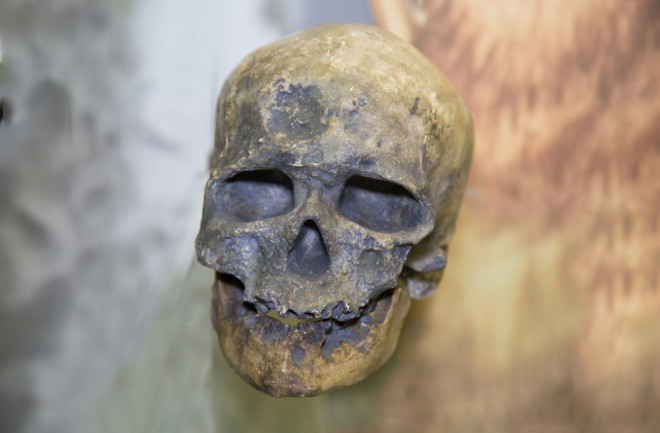In 1868, in a small limestone cave outside the French village of Les Eyzies, a geologist named Édouard Lartet found the first set of specimens showing that modern humans had prehistoric roots. He happened upon the discovery due to road construction and later uncovered four adult skeletons and one infant dating back to the upper Pleistocene, about 30,000 years ago.
The site showed that these ancient humans were not only occupying Europe at the time but that they were somewhat sophisticated, having been intentionally buried amongst animal teeth and shells that had been crafted into necklaces and pendants. The scientists called the site Cro-Magnon 1, a name which stuck with these early Homo sapiens until recent years.
Being a Cro-Magnon Was Tough
Cro-Magnons were early H. sapiens, and their survival was no easy matter. We can tell from the site that the male skeleton was likely about 50 years old at the time of his death. Researchers can see damage to his bone structure, showing he likely had a debilitating fungal infection.
Some of the other skeletons had fused spines, indicating that they had endured “traumatic injury,” and the adult female seemed to have survived a period of time with a skull fracture. The injuries also show that Cro-magnons probably cared for one another, nurturing each other’s injuries so that they could mutually survive.
Read More: An Introduction to the History of Human Evolution
Who Got to Europe First: Neanderthals or Cro-Magnons?
According to Chris Stringer, a paleoanthropologist at the London Natural History Museum, Neanderthals had evolved in Europe for hundreds of thousands of years. Using DNA evidence as well as bone and teeth fragments from a cave site at the Sima de los Huesos in Spain, researchers have shown that specimens that date back a whopping 430,000 years were Neanderthals. While H. sapiens didn’t get to Europe until 210,000 years ago at the earliest.
Read More: When Did Homo Sapiens First Appear?
Cro-Magnon vs. Neanderthal: What Is the Difference?
Even just 30,000 years ago, we can see some major differences between Cro-Magnons and Neanderthals. Cro-Magnons were taller and narrower than Neanderthals. “They have a less voluminous rib cage,” says Stringer. In some cases, Neanderthals could be as much as half a foot shorter than Cro-Magnons.
Neanderthals were shorter and squatter with stubbier extremities, likely because they evolved in a colder part of the world compared to early humans, who did most of their evolution in Africa.
There are also several differences in the skull. For example, their brain case was “higher and rounder” when compared to a Neanderthal’s skull. Early human brows were also much less pronounced, if not non-existent, compared to Neanderthals.
If you look at CT scans, says Stringer, you can also see that human ear bones are shaped differently compared to Neanderthals.
Read More: What We Know About Neanderthal Brain Size
Why We Don’t Use the Term Cro-Magnon As Much Anymore
Cro-Magnon is a term that was used earlier on because these were some of the very first specimens found to show the ancient nature of humans, says Stringer. But now, by comparison, these aren’t really that old. The term Cro-Magnon would only accurately describe H. sapiens found in the European Upper Paleolithic. “It’s a term that’s falling into disuse,” says Stringer.
At this point, we know that H. sapiens and Neanderthals evolved from a common ancestor at least 600,000 years ago, and we’ve found ancient human specimens as old as 300,000 years in Africa. A June 2017 paper in Nature documents the partial skull and skeleton of an ancient H. sapien found at Jebel Irhoud in Morocco.
Read More: Humans Evolved From A Common Ancestor That Appeared 6 Million Years Ago
Why Did the Neanderthals Go Extinct?
As a species, Neanderthals went extinct around 40,000 years ago. We initially thought that this was because humans were smarter with better tools and weapons geared toward survival. But in recent years, we’ve shown that this likely wasn’t entirely true. Neanderthals were very intelligent, with sophisticated tools, weapons, and art.
What’s more likely is that as the number of Neanderthals dwindled, they were outcompeted. Cro-Magnons had larger numbers to network and work together toward survival.
While the gap was narrow between H. sapiens and Neanderthals at the time they disappeared, humans did have things like sewing needles and more sophisticated ivory tools that could make for warmer clothes, tents, and other gear to survive those deep winter months. “Small things can add up,” says Stringer.
In the end, we don’t know for sure what happened, but it is humans who still survive today. Not to worry, even though they went extinct, we can still find remnants of Neanderthals right there in our DNA.
Read More: What Exactly Happened to The Neanderthals and Why Did They Go Extinct?

